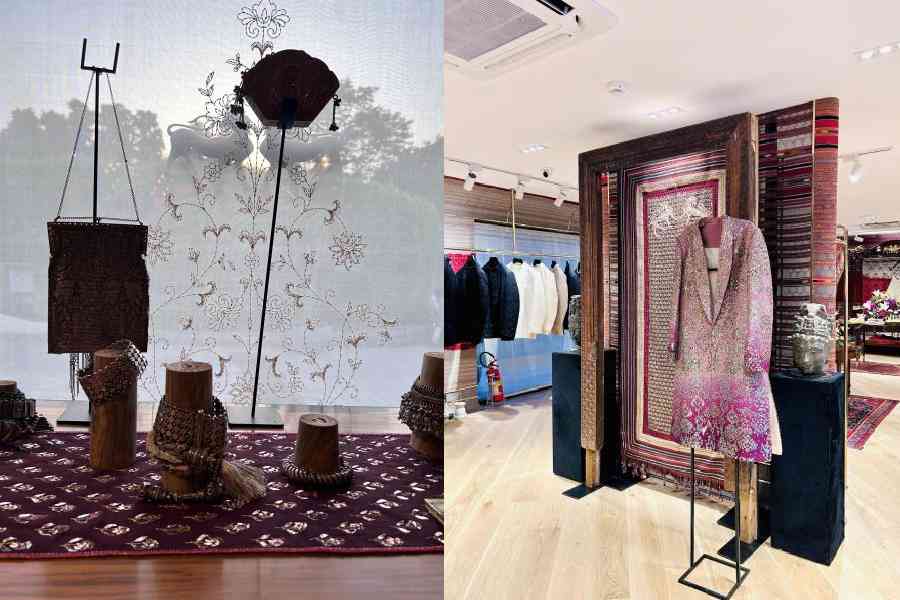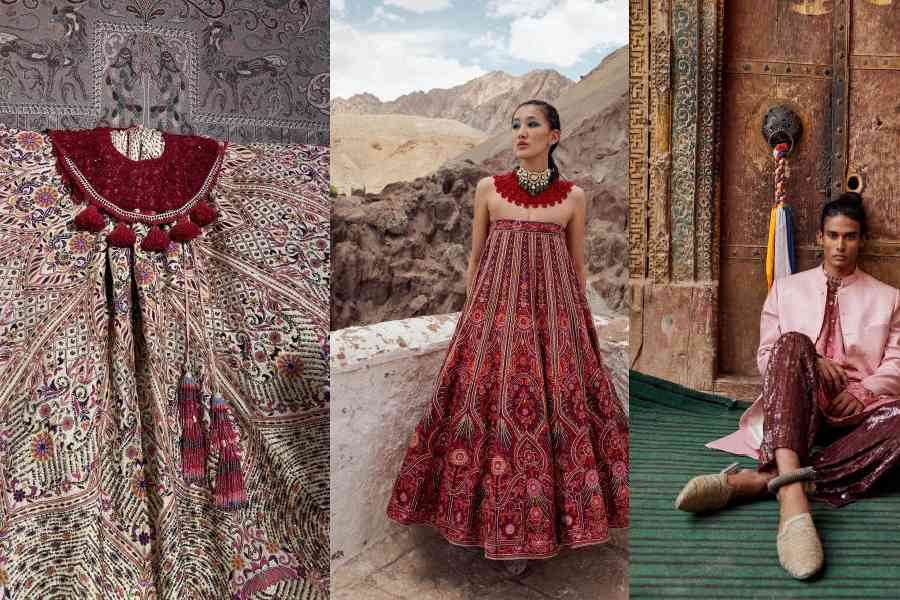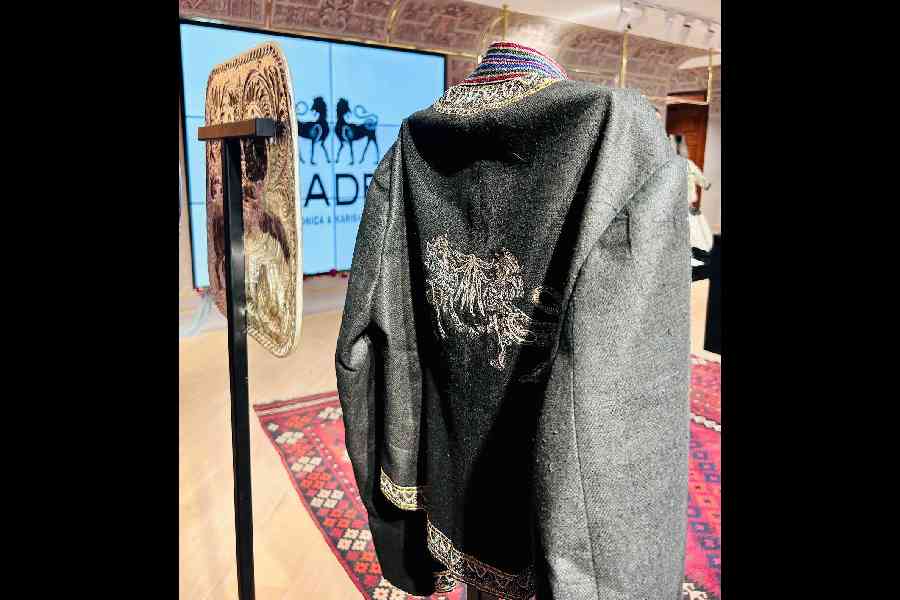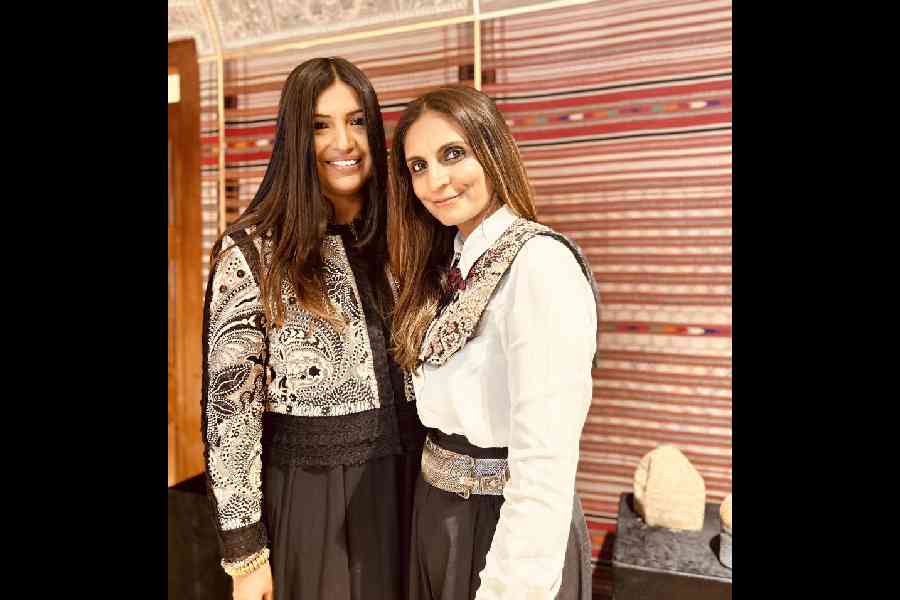The romance of the kantha curtains. The vibrant colours of the pattu shawls. The nostalgia of the artefacts. And, a certain calm. JADE by Monica & Karishma’s sprawling twin dens for men and women at 1AQ, Mehrauli, New Delhi, are set opposite each other, across an expanse of greenery, the pathway leading one to the other, strewn with art and championing what lies at the heart of the brand — the poetry of the human hand. Designed by Monica Shah, the ‘JADE spaces’ are truly one of a kind, a tour which will immerse you in the brand’s signatures of ‘ek taar’ and kasab, giving you the touch and feel of traditions that are true couture. So precious.
t2 was at the launch that also marked the brand’s 15 years. Monica Shah and Karishma Swali sat down to take us through the making of the stores and shared the secret behind the sisters-in-laws’ solid partnership.

(l-r) This was one of our favourite frames from the bespoke bridal wear room. The impossibly dreamy curtains formed the backdrop of a lovely display. Meticulously put-together installations marked the new JADE spaces
Many congratulations! How have these 15 years been for the brand?
Monica: I think it’s been a splendid journey, but there have been lots of learnings. I would love to thank everyone who’s been a huge part of it, the family, friends and my team. The vision of JADE has always been about sustaining our crafts and we hope to carry that forward. We have introduced our new logo, which is also about two lions, one looking into the past which is our artisanal legacies and the other one looking into the future, which is reminding us of our duties to how we can sustain these crafts and preserve them for our future generations. We believe that the Indian crafts are the epitome of luxury and they have survived the test of time.
Karishma: Essentially, JADE was born from a compelling spirit to be able to create without conditions, to be able to tell India’s beautiful story, embedded in so much culture and craft, but to do it in a way that also pays ode to the future and is conscious of our responsibility to preserve. So, it’s certainly been a journey where we’ve learnt so much and met so many creative energies. It’s been a wonderful exchange, but for us, what remains our biggest source of inspiration is really the artisanal communities that teach us so much through their quiet dignity and their relentless energy that they channelise into craft.

(l-r)The ek taar work, with which the brand is synonymous, was on display. "There are so many crafts that exist in India. I think these embroideries are the epitome of luxury. And ek taar is one of them, something we picked up and helped revive. It is a simple technique but it is a true luxury. It comes from Gujarat and Kashmir,” said Monica, at the launch. The 'Afsahna' lehnga from the Tara collection. The sensuous JADE man in Tara
Was there a struggle?
Monica: Not really, but it’s about how much you want to take home, right? And, you keep learning each day. There is so much craft to explore and the more you dig into it, there’s much more to learn.
Since it’s all in the family, how is it navigating the personal-professional space?
Karishma: I think to have a family where there is a collective vision, where we are all aligned towards the same core values and beliefs that guide us.... My dad founded Chanakya in the early 80s. He is an artist and an aesthete and I think they are our guiding force even today. We may do different things, but I know, at the very core, it’s the same values that guide us. Also, having this unity... there is so much strength in there and in being able to brainstorm together and really be there for each other. We are deeply fortunate.
Monica: When you share the same values, everything vibes together.
The stores are stunning...
Monica: We feel so passionate about our crafts that we know that every wall around you has to breathe that. It started with us just loving what we do. We commissioned these shawls in Barmer, Rajasthan. Some of them were sent to Bhuj then for the tie-and-dye technique of bandhni. Some of them are fully handcrafted with kantha technique (done in Mumbai). The curtains also have kantha embroidery but they are softer. So, they are completely tone-on-tone. The collectibles are from our personal archive.
Karishma: Before us, the family has been collecting. The family I am married into is also deeply embedded in art. So, we have grown up seeing it and enjoying it. The store really embodies everything we stand for. We hope everyone enjoys it.
The label has always been very young. What do your younger brides tell you when they come to you?
Monica: I think most of them are rooted in our tradition, but at the same time, they want to dress younger and contemporary and different. That’s what we have been doing, to contemporise this craft and make it younger and more wearable.

A glimpse of the art-laden bespoke bridal wear room. Handmade pattu shawls and kantha formed the charming decor of the womenswear section
‘Tara’, the 15th-anniversary special collection, looks lovely...
Monica: We tend to go towards all the warm colours. Tara is actually inspired by how the stars have always been our guiding lights. For the 15th year, we thought Tara would be the perfect thing because this journey of 15 years has been the guiding force of what we are doing now and what we’ll be doing in the future. The two triangles are the synergy between a female and a male force.
The JADE man is also so handsome...
Monica: For our beautiful brides, we needed the man to look equally good (laughs). They are also very experimental now. The colours are not as subdued as they used to be before. So, it’s changing.

A glimpse of the intricate artistry that made up the JADE aesthetics
What are great buys this wedding season?
Monica: It could be a simple ek taar lehnga which is not gold but it has the true craftsmanship and is done with threadwork, but if you see, it really is luxury and they are so beautiful, colourful. There are so many different crafts they can pick up besides zardosi. They are very light. Most of the women in Rajasthan wear these skirts to the farm. Imagine?! Embroidered skirts... so light.
What is the secret to keeping a partnership going for so many years?

The JADE menswear space saw pattu shawls and 'hand-dyed' bandhni come together in a delightful unison
Karishma: I think it’s about remembering your core values, being able to appreciate each other’s strengths and knowing the beauty of being able to love something together and doing it together. It’s also about recognising each one’s strengths and allowing them to take on that path. It’s nice to be able to have a point of view that is not yours. It’s about doing things together that go beyond work. So we take family vacations together and are very attached to each other’s kids and in a sense you realise that we are all one.
